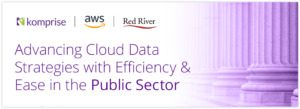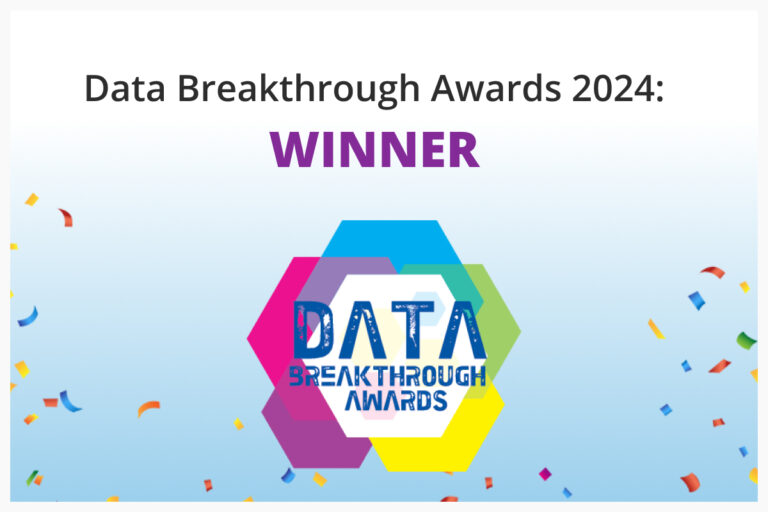
Since the onset of Covid-19, there’s been a global acceleration to the public cloud like never before. This is also true for government, which has traditionally been more conservative in its adoption of modern IT technologies and strategies.
According to a recent study by Maximus and Genesys, a majority (91-93%) of U.S. state, local, and federal governments have at least some systems and solutions in the cloud.

Public and private sector organizations have similar motivations for moving to the cloud, but the challenges and strategies can diverge. For one, public sector organizations have strict compliance requirements regarding privacy and security. For two, legacy environments are typically more ingrained and complicated and thirdly, budgets are more stringent.
Recently, Michael Del Castillo, Regional Sales Director with Komprise, teamed up with Sean Phuphanich, an AWS Senior Solutions Architect and Jeff Drewes, CTO of Consulting Services at Red River, to discuss public sector strategies for cloud data management. Below are highlights of the webinar; or you can watch the full webinar on Advancing Cloud Data Strategies.
Progressing the CapEx to OpEx Transition
The argument for reducing the hardware procurement lifecycle in exchange for on-demand services is still making its way through government agencies. The age-old model of planning IT infrastructure for years in advance and paying for it upfront is no longer viable given today’s dynamic technology environment and impatient user expectations; this model is also no longer financially astute. The cloud allows federal organizations to benefit from predicted spend, meet unexpected demand and optimize budgets yearly, if not continuously.
“CapEx requires predicting workloads and requirements three to five years in advance, which results in underutilized hardware for large parts of the lifecycle,” remarked Phuphanich. “Before I joined AWS I was working at a company where we were saving 30% a year in the cloud by continually optimizing our services and using discounts. AWS Reserved instances can be a huge savings if you understand your workloads and you always have the option to burst if you need more capacity.”
Data Governance
In the public sector, data governance is an essential underpinning of cloud infrastructure. The webinar participants talked about striking the right balance – modernizing data governance so that organizations can reduce shadow IT and its associated risks and costs yet still provide flexibility and agility for employees to use cloud services.
Instilling a strong data governance practice is paramount to ensure that data is in the appropriate locations based on its age and storage requirements and can be easily discovered and used for analytical purposes when desired.
AWS serves 7500+ government agencies around the world and complies with FedRAMP requirements.
Komprise helps support safe shadow IT through our Transparent Move Technology which securely migrates, copies and archive data to the cloud while retaining native access. Komprise’s unstructured data analytics engine quickly identifies ownership, access history, storage composition and other insights on file data to help IT managers determine where to best store data for cost and performance while also allowing individual departments to understand usage for chargeback analysis. You can model projected cost savings based on parameters like number of backup copies and internal and external storage costs, factoring in costs for Komprise.
Central Visibility
A barrier to IT directors in deploying hybrid cloud and multi-cloud infrastructure is that they can’t easily see their data and files and ensure that information assets are properly secured and managed. This lack of visibility also hampers cloud spend management. In AWS, says Phuphanich, IT directors can gain tight control over what can be deployed to which environment, settings that can be managed at the AWS services level. This ensures that IT policies transfer to the cloud while still giving developers freedom to have sandboxes and deploy where they want, within the pre-established parameters. Komprise enabled central visibility of the unstructured data, giving insight and control over the data and the associated spend.
Here are a few tips shared by Red River’s Drewes on how to plan for a cloud migration:
- Conduct a thorough assessment of your environment: know first!
- Collect costs and performance benchmarks of existing data center environments.
- Run analysis of near-term and long-term compute and storage needs.
- Understand dependencies and interactions between core IT systems.
- Gather critical requirements, such as acceptable outage windows, size of the migration and encryption requirements.
- Don’t forget post-migration planning, factoring in what tools and services are needed for ongoing management and monitoring of the cloud environment.
Komprise for AWS Data Management Use Cases:
| Cloud Data Migration | Data Analytics | Data Archiving and Tiering, Data Replication | Native Data Access | |
| Amazon EFS, FSX | ||||
| Amazon S3 and Glacier Classes | ||||
| AWS GovCloud (AMI) | ||||
| AWS Outposts |
Where Komprise Can Help:
Komprise Intelligent Data Management can analyze unstructured data at more than 10 PB/day.
- Leveraging Komprise Deep Analytics, you can create detailed migration plans involving owners, groups, access time and other file metadata.
- Archiving and migration plans can be tested within the Komprise UI, showing up-to-date ROI calculations.
- Migrate data 27x faster using an iterative process and automated error handling.
- Automatic archiving for cool and cold data combined with AWS lifecycle management to AWS Glacier and Deep Glacier storage, based on last access time.
Using Komprise for AWS migrations can help estimate the ROI of AWS in your environment, move data transparently to any storage class in AWS, and do ongoing lifecycle management of the moved data with simple automated policies. Read more about Komprise for AWS benefits and check out the white paper: Smartest Path for Public Sector File Data to the Cloud – Storage-Driven vs File-Driven, which is better and why.




